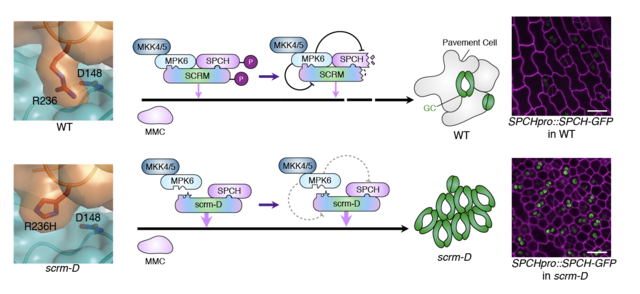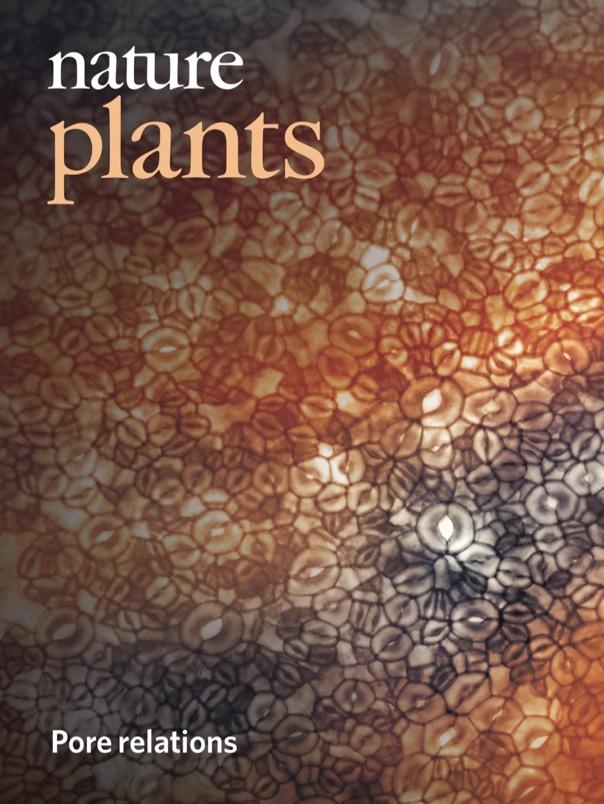Research Highlights
SPEECHLESS, SCREAM and Stomata Development in Plant Leaves
A Nagoya University and Washington University-led team of scientists with two disparate sets of expertise - in plant biology and protein structural chemistry - have unraveled the atomic basis of how optimal numbers of stomata are made in leaves.
Plants constantly make trade-offs in their decisions: more light means more opportunity for photosynthesis, but then hot temperatures and dry air makes wilting more likely. Stomata - microscopic valves on the surface of a leaf's epidermis - are at the forefront of these trade-offs: stomata open to acquire fresh air (and the carbon dioxide in it) for photosynthesis, but water loss through stomatal pores causes plants to become dehydrated, and eventually to wilt.
The proper number and distribution of stomata on leaves is critical for plant productivity. Using the model plant Arabidopsis thaliana, a group of scientists including Keiko Torii (Howard Hughes Medical Institute/University of Washington and Institute of Transformative Biomolecules (ITbM) at Nagoya University), have identified key genes that make stomata and enforce proper stomatal patterning.
About the research:
When a leaf starts to make epidermal cells, whether the initial cell becomes a stoma or non-stomatal epidermal cell is not yet decided. Differentiation of stomata starts when the master-regulatory proteins, SPEECHLESS and SCREAM, regulate gene expression. On the other hand, SPEECHLESS is inhibited by cellular signals involving MAP kinases MPK3 and MPK6, which transmit environmental signals to a cell. Depending on whether the master-regulatory proteins or the MAP kinases win, the initial cell becomes a stoma or non-stomatal epidermal cell. Nonetheless, the exact mechanism of how MPK3 and 6 inhibit SPEECHLESS was unclear until recently.
In the paper published in Nature Plants, Dr. Aarthi Putarjunan, Prof. Keiko Torii and colleagues discovered that the SCREAM protein possesses a pair of anchoring motifs that directly bridges MAP kinases (MPK3 and MPK6) to SPEECHLESS. A single amino-acid mutation in this SCREAM-anchoring motif causes an inability to recruit inhibitory MAP kinases, which results in a striking leaf epidermis covered solely by an enormous number of stomata (see Figure 1).

Figure 1. From left to right: Wild type stomata; SPEECHLESS (no stomata mutant); and SCREAM-D mutant (stomata-only leaf epidermis) in leaves of Arabidopsis (rockcress), a small flowering plant related to cabbage and mustard. Image: Aarthi Putarjunan (U. Washington)/Keiko Torii (Nagoya University /U. Washington).
To understand how SCREAM anchors the MAP kinases, Putarjunan and Torii initiated a collaboration with Prof. Ning Zheng, a structural biologist who crystalizes proteins, and Prof. Florence Tama, a theoretical chemist who simulates and models protein-protein interactions. Together with these two protein-structure experts, the group solved the structure of the plant MAP kinase MPK6 and revealed the mechanism, at the atomic level, of how SCREAM brings about inhibitory MAP kinases. (See Fig. 2)
 Figure 2. Mechanism enforcing the initiation of stomatal cell lineages via SCREAM's unique anchoring module that recruits MAP kinases.
Figure 2. Mechanism enforcing the initiation of stomatal cell lineages via SCREAM's unique anchoring module that recruits MAP kinases.
Interestingly, MAP kinases play critical roles in cell proliferation and differentiation between human beings; moreover, dysfunction of MAP kinases is directly associated with cancers. While the structure of the plant MAP kinase MPK6, which was solved in this study, is nearly identical to that of human MAP kinases, the way the plant MAP kinase binds with SCREAM is different from how human MAP kinases bind with their 'client' proteins. This implies that plants may have evolved a unique motif to control a cell fate decision via the recruitment of the highly conserved signaling protein, the MAP kinases.
The atomic insight revealed in this study may be harnessed to design optimal stomatal development that allows plants to cope with the changing climate, and may also provide a tool for tweaking cellular processes mediated by MAP kinases in animals (e.g. humans) for basic biomedical research.

Figure 3. The 'screaming' stomata-only leaf epidermis of an Arabidopsis scream-D mutant, which cannot recruit MAP kinases to properly enforce stomatal development.
Shown is the cover of the July 2019 issue of NATURE PLANTS (© Nature Publication Group).
Journal Information:
The article "Bipartite anchoring of SCREAM enforces stomatal initiation by coupling MAP kinases to SPEECHLESS," by Aarthi Putarjunan, Jim Ruble, Ashutosh Srivastava, Chunzhao Zhao, Amanda L. Rychel, Alex K. Hofstetter, Xiaobo Tang, Jian-Kang Zhu, Florence Tama, Ning Zheng & Keiko U. Torii is published in Nature Plants
DOI: 10.1038/s41477-019-0440-x
2019-06-25

